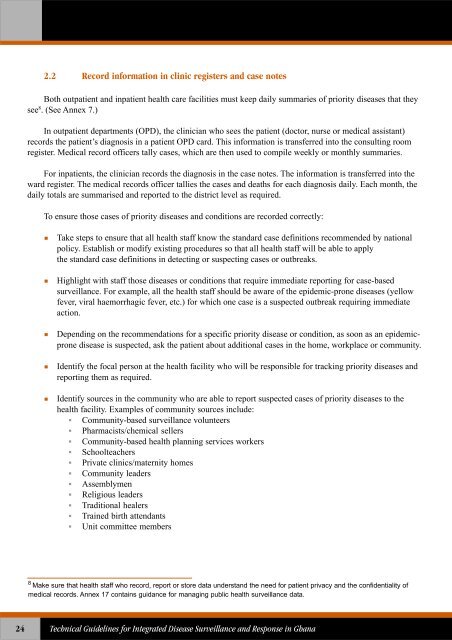Technical Guidelines for Integrated Disease Surveillance ... - PHRplus
Technical Guidelines for Integrated Disease Surveillance ... - PHRplus
Technical Guidelines for Integrated Disease Surveillance ... - PHRplus
You also want an ePaper? Increase the reach of your titles
YUMPU automatically turns print PDFs into web optimized ePapers that Google loves.
2.2 Record in<strong>for</strong>mation in clinic registers and case notesBoth outpatient and inpatient health care facilities must keep daily summaries of priority diseases that theysee 8 . (See Annex 7.)In outpatient departments (OPD), the clinician who sees the patient (doctor, nurse or medical assistant)records the patient’s diagnosis in a patient OPD card. This in<strong>for</strong>mation is transferred into the consulting roomregister. Medical record officers tally cases, which are then used to compile weekly or monthly summaries.For inpatients, the clinician records the diagnosis in the case notes. The in<strong>for</strong>mation is transferred into theward register. The medical records officer tallies the cases and deaths <strong>for</strong> each diagnosis daily. Each month, thedaily totals are summarised and reported to the district level as required.To ensure those cases of priority diseases and conditions are recorded correctly:Take steps to ensure that all health staff know the standard case definitions recommended by nationalpolicy. Establish or modify existing procedures so that all health staff will be able to applythe standard case definitions in detecting or suspecting cases or outbreaks.Highlight with staff those diseases or conditions that require immediate reporting <strong>for</strong> case-basedsurveillance. For example, all the health staff should be aware of the epidemic-prone diseases (yellowfever, viral haemorrhagic fever, etc.) <strong>for</strong> which one case is a suspected outbreak requiring immediateaction.Depending on the recommendations <strong>for</strong> a specific priority disease or condition, as soon as an epidemicpronedisease is suspected, ask the patient about additional cases in the home, workplace or community.Identify the focal person at the health facility who will be responsible <strong>for</strong> tracking priority diseases andreporting them as required.Identify sources in the community who are able to report suspected cases of priority diseases to thehealth facility. Examples of community sources include: Community-based surveillance volunteers Pharmacists/chemical sellers Community-based health planning services workers Schoolteachers Private clinics/maternity homes Community leaders Assemblymen Religious leaders Traditional healers Trained birth attendants Unit committee members8 Make sure that health staff who record, report or store data understand the need <strong>for</strong> patient privacy and the confidentiality ofmedical records. Annex 17 contains guidance <strong>for</strong> managing public health surveillance data.24<strong>Technical</strong> <strong>Guidelines</strong> <strong>for</strong> <strong>Integrated</strong> <strong>Disease</strong> <strong>Surveillance</strong> and Response in Ghana















